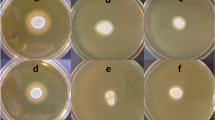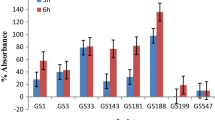Abstract
The gluten content of rye sourdough during fermentation was monitored by a competitive ELISA based on the R5 antibody. Although a time-dependent decrease was found, the gluten content was not reduced below the threshold for gluten-free foods of 20 mg/kg, even after prolonged fermentation. Instead, Aspergillus niger prolyl endopeptidase (AN-PEP) extensively degraded gluten concentrations of up to 80,000 mg/kg in rye flour, rye sourdough, and sourdough starter under distinct temperatures and pH values. The enzyme did not lead to inactivation of the microorganisms in the sourdough starter. Gluten-free rye flour alone or in combination with sourdough starter was used to produce gluten-free bread, which was evaluated for its sensory properties. Whereas gluten-free sourdough bread had poor sensory attributes compared to a conventional rye bread used as reference, the replacement of sourdough by egg proteins yielded gluten-free bread comparable to the reference and with higher sensory quality than bread prepared from naturally gluten-free ingredients. Therefore, the feasibility of producing high-quality bread from originally gluten-containing cereals such as rye by means of treatment with AN-PEP has been shown. Rye products rendered gluten-free in this manner have the potential to increase the choice of high-quality gluten-free foods for celiac patients.



Similar content being viewed by others
References
Wieser H, Konitzer K, Koehler P (2012) Celiac disease—multidisciplinary approaches. Cereal Foods World 57:215–224
Codex standard for foods for special dietary use for persons intolerant to gluten (2008) Codex Alimentarius, International food standards. CODEX STAN 118-1979, adopted in 1979; amended 1983; revised 2008. Rome, Italy
Commission Regulation (EC) No 41/2009 of 21 January 2009 concerning the composition and labelling of foodstuffs suitable for people intolerant to gluten. Off J Eur Union 2009;16(3)
Shan L, Molberg O, Parrot I, Hausch F, Filiz F, Gray GM, Sollid LM, Khosla C (2002) Structural basis for gluten intolerance in celiac sprue. Science 297:2275–2279
Edens L, van Der Hoeven RAM, De Roos AL, Harvey M (2005) Use of proline-specific endoproteases to hydrolyse proline-rich peptides at acid pH in food processing. International patent WO2005/027953A2, 31 March 2005
Hartmann G, Koehler P, Wieser H (2006) Rapid degradation of gliadin peptides toxic for coeliac disease patients by proteases from germinating cereals. J Cereal Sci 44:368–371
Sollid LM (2002) Coeliac disease: dissecting a complex inflammatory disorder. Nat Rev Immunol 2:647–655
Gessendorfer B, Hartmann G, Wieser H, Koehler P (2011) Determination of celiac disease-specific peptidase activity of germinated cereals. Eur Food Res Technol 232:205–209
Lopez M, Edens L (2005) Effective prevention of chill-haze in beer using an acid proline-specific endoprotease from Aspergillus niger. J Agric Food Chem 53:7944–7949
Stepniak D, Spaenij-Dekking L, Mitea C, Moester M, de Ru A, Baak-Pablo R, van Veelen P, Edens L, Koning F (2006) Highly efficient gluten degradation with a newly identified prolyl endoprotease: implications for celiac disease. Am J Physiol 291:G621–G629
Schwalb T, Wieser H, Koehler P (2012) Studies on the gluten-specific peptidase activity of germinated grains from different cereal species and cultivars. Eur Food Res Technol 235:1161–1170
Walter T, Wieser H, Koehler P (2014) Production of gluten-free wheat starch by peptidase treatment. J Cereal Sci 60:202–209
Walter T, Wieser H, Koehler P (2014) Degradation of gluten in wheat bran and bread drink by means of a proline-specific peptidase. J Nutr Food Sci 4:293
Sikka KC, Duggal SK, Singh R, Gupta DP, Joshi MG (1978) Comparative nutritive value and amino acid content of triticale, wheat, and rye. J Agric Food Chem 26:788–791
Vinkx CJA, Van Nieuwenhove CG, Delcour JA (1991) Physicochemical and functional properties of rye nonstarch polysaccharides. III. Oxidative gelation of a fraction containing water-soluble pentosans and proteins. Cereal Chem 68:617–622
Vinkx CJA, Delcour JA (1996) Rye (Secale cereale L.) arabinoxylans: a critical review. J Cereal Sci 24:1–14
Wieser H, Vermeulen N, Gaertner F, Jaensch A, Vogel RF (2008) Degradation of gluten proteins during sourdough fermentation. Cereal Technol 62:38–45
Wieser H, Vermeulen N, Gaertner F, Vogel RF (2008) Effects of different Lactobacillus and Enterococcus strains and chemical acidification regarding degradation of gluten proteins during sourdough fermentation. Eur Food Res Technol 226:1495–1502
Moroni AV, Dal Bello F, Arendt EK (2009) Sourdough in gluten-free bread-making: an ancient technology to solve a novel issue? Food Microbiol 26:676–684
Clark KJ, Gaitan CH, Taylor SL, Walter J (2011) Identification of probiotic strains capable of gluten peptide degradation. J Allergy Clin Immun 127:AB243–AB243
Greco L, Gobbetti M, Auricchio R, Di MR, Landolfo F, Paparo F, Di CR, De AM, Rizzello CG, Cassone A, Terrone G, Timpone L, D’Aniello M, Maglio M, Troncone R, Auricchio S (2011) Safety for patients with celiac disease of baked goods made of wheat flour hydrolyzed during food processing. Clin Gastroenterol Hepatol 9:24–29
Gerez CL, Dallagnol A, Rollan G, de Valdez GF (2012) A combination of two lactic acid bacteria improves the hydrolysis of gliadin during wheat dough fermentation. Food Microbiol 32:427–430
Giuliani G, Benedusi A, Di Cagno R, Rizzello CG, De Angelis M, Gobbetti M, Cassone A (2010) Process of microbic biotechnology for completely degrading gluten in flours. International patent WO2010073283A2, 1 July 2010
Boecker E-J (2005) Process for preparing a sourdough with homo- and heterofermentative lactobacillus. European patent EP1110458B1, 7 Dec 2005
Bailey MJ, Biely P, Poutanen K (1992) Interlaboratory testing of methods for assay of xylanase activity. J Biotechnol 23:257–270
Valdes I, Garcia E, Llorente M, Mendez E (2003) Innovative approach to low-level gluten determination in foods using a novel sandwich enzyme-linked immunosorbent assay protocol. Eur J Gastroen Hepat 15:465–474
R-Biopharm (2007) RIDASCREEN® Gliadin competitive—enzyme immunoassay for the quantitative analysis of peptide fragments of gliadins and corresponding prolamines, pp 11–17
Selmair PL, Koehler P (2008) Baking performance of synthetic glycolipids in comparison to commercial surfactants. J Agric Food Chem 56:6691–6700
Sensory analysis-Methodology-General guidance for establishing a sensory profile, 2003. ISO 13299:2003
Gobbetti M, Rizzello CG, Di Cagno R, De Angelis M (2007) Sourdough lactobacilli and celiac disease. Food Microbiol 24:187–196
Loponen J, Sontag-Strohm T, Venaelaeinen J, Salovaara H (2007) Prolamin hydrolysis in wheat sourdoughs with differing proteolytic activities. J Agric Food Chem 55:978–984
Koehler P, Schwalb T, Immer U, Lacorn M, Wehling P, Don C (2013) AACCI approved methods technical committee report: collaborative study on the immunochemical determination of partially hydrolyzed gluten by an R5 competitive ELISA. Cereal Foods World 58:154–158
Arendt EK, Morrissey A, Moore MM, Dal Bello F (2008) Gluten-free breads. In: Arendt EK, Dal Bello F (eds) Gluten-free cereal products and beverages. Elsevier, Burlington, pp 289–319
Acknowledgments
The authors thank Leibniz-Gemeinschaft (WGL) for financial support of this project (SAW-2011-DFA-1).
Conflict of interest
None.
Compliance with Ethics Requirements
This article does not contain any studies with human or animal subjects.
Author information
Authors and Affiliations
Corresponding author
Rights and permissions
About this article
Cite this article
Walter, T., Wieser, H. & Koehler, P. Degradation of gluten in rye sourdough products by means of a proline-specific peptidase. Eur Food Res Technol 240, 517–524 (2015). https://doi.org/10.1007/s00217-014-2350-5
Received:
Revised:
Accepted:
Published:
Issue Date:
DOI: https://doi.org/10.1007/s00217-014-2350-5




